Introduction
The results reported in the July 2019 bank lending survey (BLS) relate to changes observed during the second quarter of 2019 and expectations for the third quarter of 2019. The survey was conducted between 17 June and 2 July 2019. The response rate was 99%. In addition to results for the euro area as a whole, this report also contains results for the five largest euro area countries.[1]
A number of ad hoc questions were included in the July 2019 survey. They address the impact of the situation in financial markets on banks’ access to retail and wholesale funding, the impact of ongoing regulatory or supervisory changes on banks’ lending policies and the impact of banks’ non-performing loan (NPL) ratios on their lending policies.
1 Overview of results
According to the July 2019 bank lending survey, credit standards tightened in the second quarter of 2019 for loans to enterprises, marking the end of the net easing period started in 2014, as concerns about the economic outlook and increased risk aversion translated into tighter internal guidelines and loan approval criteria despite favourable funding conditions. Credit standards also tightened for consumer credit, in line with developments in the previous quarter, while they remained broadly unchanged for housing loans after a tightening during the previous quarter. Loan demand continued to increase across all loan categories.
Credit standards (i.e. banks’ internal guidelines or loan approval criteria) for loans to enterprises tightened in the second quarter of 2019 (net percentage of reporting banks at 5%, after -1% in the first quarter of 2019; see overview table), while banks had expected a slight net easing in the previous survey round. Credit standards on loans to households for house purchase remained broadly unchanged (net percentage of reporting banks at -1%, after 3% in the first quarter of 2019), in contrast to expectations of a net tightening. Credit standards on consumer credit and other lending to households continued to tighten further (4%, increasing from 2% in the previous quarter), substantially revising the net easing expected in the previous quarter (-9%). For the third quarter of 2019, banks expect credit standards to remain unchanged for loans to enterprises and housing loans, and to ease for consumer credit (-4%).
Banks’ risk perceptions (related to a deterioration in the general economic and firm-specific situation) and risk tolerance, as well as cost of funds and balance sheet constraints (driven by costs related to banks’ capital position), contributed to a tightening of credit standards on loans to enterprises, while competition (mainly from other banks) exerted pressure in the opposite direction. For loans to households for house purchase, a decrease in risk tolerance and an increase in banks’ cost of funds and balance sheet constraints offset the easing pressure from competition and, to a lesser extent, lower risk perceptions. For consumer credit and other lending to households, risk aversion was the main driver of the net tightening, only partially compensated by the impact of competition and a reduction in risk perception.
Banks’ overall credit terms and conditions (i.e. banks’ actual terms and conditions agreed in the loan contract) for new loans to enterprises tightened for the second consecutive quarter, following an uninterrupted easing since the introduction of this summary indicator in 2015. The tightening affected margins on average NFC loans (defined as the spread over relevant market reference rates) and was especially prevalent among margins on riskier loans, potentially signalling the end of a favourable cycle that has endured since 2013. Collateral requirements also became stricter. For housing loans, banks’ overall terms and conditions remained broadly unchanged, with the decrease in the margins on average loans compensating for the increase in the margins on risker loans. A similar development characterised consumer credit, although the more widespread reduction in average margins tilted the balance of contributions towards a slight easing of terms and conditions, despite stricter collateral standards required for this type of lending.
The net percentage share of rejected loan applications increased across all loan categories, in particular for loans to enterprises.
Net demand for loans to enterprises increased in the second quarter of 2019, in line with expectations and consistent with the buoyancy of corporate demand for credit since 2014 (net percentage of 6%, after 0% in the first quarter of 2019; see overview table). Banks expect demand to keep expanding in the next quarter (net percentage of 5%). The net increase in demand was similar for consumer credit (net percentage of 6%, after 2%) and substantially more pronounced for housing loans (net percentage of 26% after 14%), reaching one of the highest figures since the start of the survey in 2003. For the following quarter, banks expect an increase in net demand for housing loans (6%) and for consumer credit (11%).
Demand for loans to enterprises was supported by the low general level of interest rates and fixed investment, although to a lesser extent. M&A activity also contributed to the expansion of demand. The contribution coming from the accumulation of inventories and the recourse to working capital was marginally negative for the first time since 2013. Net demand for housing loans continued to be driven mainly by the low general level of interest rates, with increased contributions from positive housing market prospects, increased consumer confidence, new regulatory and fiscal regimes of housing markets in some jurisdictions and favourable debt renegotiations compared to previous quarters. For consumer credit and other lending to households, the low general level of interest rates and spending on durable goods contributed positively to demand, although to a decreasing degree. A rebound in consumer confidence, which had faltered only in the previous quarter since the second quarter of 2014, helped to prop up demand for consumer credit.
Among the largest euro area countries, credit standards on loans to enterprises tightened considerably in France, in Italy and, to a lesser extent, in Germany, while they remained unchanged in Spain and continued easing in the Netherlands in the second quarter of 2019 (see overview table). For housing loans, credit standards eased in the Netherlands, Germany and France, remained unchanged in Italy, and tightened in Spain. Net demand for loans to enterprises increased in France, Italy and Germany, while it declined in the Netherlands and Spain in the second quarter of 2019. For housing loans, net demand increased in most large euro area countries, except for Spain where it remained unchanged.
Overview table
Latest developments in BLS results in the largest euro area countries
(net percentages of banks reporting tightening credit standards or an increase in loan demand)

Notes: The “Avg.” columns contain historical averages, which are calculated over the period since the beginning of the survey, excluding the most recent round. For France and the Netherlands, net percentages are weighted on the basis of outstanding loan amounts for individual banks in the respective national samples.
The July 2019 BLS also included a number of ad hoc questions. Banks reported in net terms that access to wholesale funding continued to improve in the second quarter of 2019 for debt securities and to a smaller extent also for money markets, while access to securitisation improved slightly. Banks also indicated an improvement in retail funding for the second quarter of 2019.
Euro area banks continued to strengthen their capital position against the backdrop of regulatory or supervisory actions in the first half of 2019. At the euro area level, banks reported a tightening impact on their credit standards across all loan categories, with further tightening expected for the next six months accompanied by a widening of credit margins across all loan categories.
Regarding the impact of non-performing loan (NPL) ratios on credit standards, banks reported a tightening for all loan categories in the first half 2019, although the impact was less pronounced than in the previous semester for loans to enterprises and housing loans. Over the next six months, they expect a tightening impact for loans to enterprises and consumer credit. Risk perceptions and risk aversion were the main drivers of the tightening impact of NPL ratios.
Box 1
General notes
The bank lending survey (BLS) is addressed to senior loan officers at a representative sample of euro area banks. In the current survey round, 144 banks participated in the survey, representing all euro area countries and reflecting the characteristics of their respective national banking structures. The main purpose of the BLS is to enhance the Eurosystem’s knowledge of bank lending conditions in the euro area.[2]
BLS questionnaire
The BLS questionnaire contains 22 standard questions on past and expected future developments: 18 backward-looking questions and four forward-looking questions. In addition, it contains one open-ended question. Those questions focus on developments in loans to euro area residents (i.e. domestic and euro area cross-border loans) and distinguish between three loan categories: loans or credit lines to enterprises; loans to households for house purchase; and consumer credit and other lending to households. For all three categories, questions are asked about the credit standards applied to the approval of loans, the terms and conditions of new loans, loan demand, the factors affecting loan supply and demand conditions, and the percentage of loan applications that are rejected. Survey questions are generally phrased in terms of changes over the past three months or expected changes over the next three months. Survey participants are asked to indicate in a qualitative way the strength of any tightening or easing or the strength of any decrease or increase, reporting changes using the following five-point scale: (1) tightened/decreased considerably, (2) tightened/decreased somewhat, (3) basically no change, (4) eased/increased somewhat or (5) eased/increased considerably.
In addition to the standard questions, the BLS questionnaire may contain ad hoc questions on specific topics of interest. Whereas the standard questions cover a three-month time period, the ad hoc questions tend to refer to changes over a longer time period (e.g. over the past and next six months).
Aggregation of banks’ replies to national and euro area BLS results
The responses of the individual banks participating in the BLS are aggregated in two steps. In the first step, the responses of individual banks are aggregated to form national results for euro area countries. And in the second step, those national BLS results are aggregated to form euro area BLS results.
In the first step, banks’ replies can be aggregated to form national BLS results by applying equal weights to all banks in the sample[3] or, alternatively, by applying a weighting scheme based on outstanding loans to non-financial corporations and households for the individual banks in the respective national samples. Specifically, for France, Malta, the Netherlands and Slovakia, an explicit weighting scheme is applied.
In the second step, since the numbers of banks in the national samples differ considerably and do not always reflect those countries’ respective shares of lending to euro area non-financial corporations and households, the national survey results are aggregated to form euro area BLS results by applying a weighting scheme based on national shares of outstanding loans to euro area non-financial corporations and households.
BLS indicators
Responses to questions related to credit standards are analysed in this report by looking at the difference (the “net percentage”) between the percentage of banks reporting that credit standards applied in the approval of loans have been tightened and the percentage of banks reporting that they have been eased. For all questions, the net percentage is determined on the basis of all participating banks that have business in or exposure to the respective loan categories (i.e. they are all included in the denominator when calculating the net percentage). This means that banks that specialise in certain loan categories (e.g. banks that only grant loans to enterprises) are only included in the aggregation for those categories. All other participating banks are included in the aggregation of all questions, even if a bank replies that a question is “not applicable” (“NA”). This harmonised aggregation method was introduced by the Eurosystem in the April 2018 BLS. It has been applied to all euro area and national BLS results in the current BLS questionnaire, including backdata.[4] The resulting revisions for the standard BLS questions have generally been small, but revisions for some ad hoc questions have been larger owing to a higher number of “not applicable” replies by banks.
A positive net percentage indicates that a larger proportion of banks have tightened credit standards (“net tightening”), whereas a negative net percentage indicates that a larger proportion of banks have eased credit standards (“net easing”).
Likewise, the term “net demand” refers to the difference between the percentage of banks reporting an increase in loan demand (i.e. an increase in bank loan financing needs) and the percentage of banks reporting a decline. Net demand will therefore be positive if a larger proportion of banks have reported an increase in loan demand, whereas negative net demand indicates that a larger proportion of banks have reported a decline in loan demand.
In the assessment of survey balances for the euro area, net percentages between -1 and +1 are generally referred to as “broadly unchanged”. For the country results, net percentage changes are reported in a factual manner, as differing sample sizes across countries mean that the answers of individual banks have differing impacts on the magnitude of net percentage changes.
In addition to the “net percentage” indicator, the ECB also publishes an alternative measure of banks’ responses to questions related to changes in credit standards and net demand. This measure is the weighted difference (“diffusion index”) between the percentage of banks reporting that credit standards have been tightened and the percentage of banks reporting that they have been eased. Likewise, as regards demand for loans, the diffusion index refers to the weighted difference between the percentage of banks reporting an increase in loan demand and the percentage of banks reporting a decline. The diffusion index is constructed in the following way: lenders who have answered “considerably” are given a weight (score of 1) twice as high as lenders having answered “somewhat” (score of 0.5). The interpretation of the diffusion indices follows the same logic as the interpretation of net percentages.
Detailed tables and charts based on the responses provided can be found in Annex 1 for the standard questions and Annex 2 for the ad hoc questions. In addition, BLS time series data are available on the ECB’s website via the Statistical Data Warehouse.
A copy of the questionnaire, a glossary of BLS terms and a BLS user guide with information on the BLS series keys can all be found at: https://www.ecb.europa.eu/stats/ecb_surveys/bank_lending_survey/html/index.en.html
2 Developments in credit standards, terms and conditions, and net demand for loans in the euro area
2.1 Loans to enterprises
2.1.1 Credit standards tightened for loans to enterprises
Credit standards (i.e. banks’ internal guidelines or loan approval criteria) for loans to enterprises tightened in the second quarter of 2019 (net percentage of reporting banks at 5%, after -1% in the first quarter of 2019; see Chart 1 and overview table). By contrast, banks had expected a slight net easing in the previous round. Although the net percentage remained below the historical average since 2003, the tightening marked the end of the net easing period that began in 2014. Across firm size, credit standards tightened for loans to small and medium-sized enterprises (5%) and remained broadly unchanged for loans to large firms (1%).
Chart 1
Changes in credit standards applied to the approval of loans or credit lines to enterprises, and contributing factors
(net percentages of banks reporting tightening credit standards and contributing factors)

Notes: “Actual” values are changes that have occurred, while “expected” values are changes anticipated by banks. Net percentages are defined as the difference between the sum of the percentages of banks responding “tightened considerably” and “tightened somewhat” and the sum of the percentages of banks responding “eased somewhat” and “eased considerably”. The net percentages for responses to questions related to contributing factors are defined as the difference between the percentage of banks reporting that the given factor contributed to a tightening and the percentage reporting that it contributed to an easing. “Cost of funds and balance sheet constraints” is the unweighted average of “costs related to capital position”, “access to market financing” and “liquidity position”; “risk perceptions” is the unweighted average of “general economic situation and outlook”, “industry or firm-specific situation and outlook/borrower’s creditworthiness” and “risk related to the collateral demanded”; “competition” is the unweighted average of “competition from other banks”, “competition from non-banks” and “competition from market financing”.
Banks’ risk perceptions (related to a deterioration in the general economic and firm-specific situation) and risk tolerance, as well as cost of funds and balance sheet constraints (driven by costs related to banks’ capital position), contributed to a tightening of credit standards on loans to enterprises, while competition (mainly from other banks) exerted pressure in the opposite direction (see Chart 1 and Table 1).[5]
Among the large euro area countries, credit standards on loans to enterprises tightened considerably in France, in Italy and, to a lesser extent, in Germany, while they remained unchanged in Spain and continued easing in the Netherlands in the second quarter of 2019. Competitive pressure contributed to an easing of credit standards in all large countries. By contrast, risk perceptions related to the general economic and firm-specific situation contributed to a tightening in most large countries, except for the nil contribution in the Netherlands. A decrease in risk tolerance added tightening pressure in Italy and France. Banks in all jurisdictions except Italy referred to a tightening impact of the cost related to banks’ capital position (included in “Cost of funds and balance sheet constraints”).
Looking ahead to the third quarter of 2019, euro area banks foresee no change in credit standards for loans to enterprises.
Table 1
Factors contributing to the net tightening of credit standards for loans or credit lines to enterprises
(net percentages of banks)
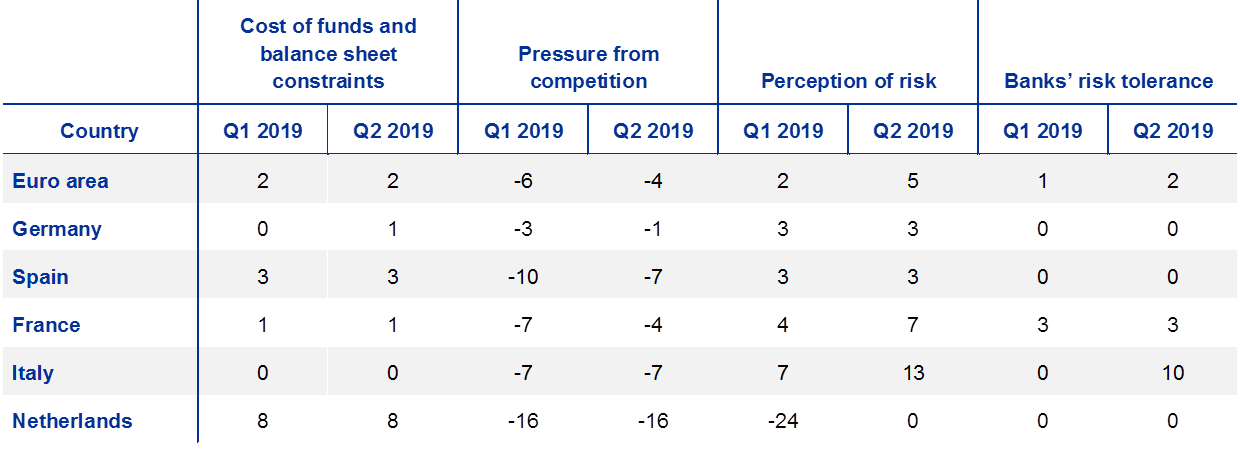
Note: See the notes to Chart 1.
2.1.2 Terms and conditions for loans to enterprises tightened
In the second quarter of 2019, overall terms and conditions that banks apply when granting new loans or credit lines (i.e. the actual terms and conditions agreed in the loan contract) to enterprises tightened for the second consecutive quarter (see Chart 2 and Table 2), following an uninterrupted easing since the introduction of this summary indicator in 2015. The tightening affected margins on average NFC loans (defined as the spread over relevant market reference rates) and was especially prevalent among margins on riskier loans, signalling the end of a favourable cycle that had endured since 2013. Collateral requirements also became stricter. Regarding other credit terms and conditions, loan size and loan covenants contributed to an easing, while non-interest rate charges had some tightening impact.
Chart 2
Changes in terms and conditions for loans or credit lines to enterprises
(net percentages of banks reporting tightening terms and conditions)

Notes: “Margins” are defined as the spread over a relevant market reference rate. “Other terms and conditions” is the unweighted average of “non-interest rate charges”, “size of the loan or credit line”, “loan covenants” and “maturity”.
Across the largest euro area countries, overall terms and conditions on new loans or credit lines to enterprises tightened in France and Germany, while they eased in Spain. The tightening was mostly related to a widening of margins on average and riskier loans. The latter have also increased in Spain and Italy, while there was no relevant change to any component in the Netherlands in the second quarter of 2019.
Table 2
Changes in terms and conditions for loans or credit lines to enterprises
(net percentages of banks)

Note: See the notes to Chart 2.
Regarding the factors contributing to changes in overall credit terms and conditions, risk perceptions were the main driver of the tightening, followed by banks’ cost of funds and balance sheet constraints, while competition continued to ease terms and conditions (see Table 3).
Across the largest euro area countries, competitive pressure contributed to easier credit terms and conditions in all countries. Risk perceptions were concentrated in France and Italy, with the former experiencing also lower risk tolerance. Cost of funds and balance sheet constraints originated tighter terms and conditions in Germany and the Netherlands, while contributed to an easing in Spain.
Table 3
Factors contributing to the net tightening of overall terms and conditions for loans or credit lines to enterprises
(net percentages of banks)

Note: The net percentages for these questions relating to contributing factors are defined as the difference between the percentage of banks reporting that the given factor contributed to a tightening and the percentage reporting that it contributed to an easing.
2.1.3 Rejection rate for loans to enterprises continued to increase
The net percentage share of rejected loan applications (i.e. the difference between the sum of the percentages of banks reporting an increase and that of banks reporting a decline in the share of loan rejections) continued to increase for loans to euro area enterprises in the second quarter of 2019, reaching the highest level (7%, after 2% in the previous quarter; see Chart 3) registered since the start of the series in 2015.
Chart 3
Change in the share of rejected applications for loans to enterprises
(net percentages of banks reporting an increase in the share of rejections)

Note: Share of loan rejections relative to the volume of all loan applications in that loan category.
Across the largest euro area countries, the net rejection rate increased in the Netherlands, France and Germany, while it remained unchanged in Spain and declined in Italy.
2.1.4 Net demand for loans to enterprises increased
Net demand for loans to enterprises increased in the second quarter of 2019, in line with expectations and consistent with the buoyancy of corporate demand for credit since 2014 (net percentage of 6%, after 0% in the first quarter of 2019; see Chart 4 and overview table). Demand increased for loans to SMEs but decreased for loans to large firms.
Across the large euro area countries, net demand for loans to enterprises increased in Germany, France and Italy, while it declined in the Netherlands and in Spain.
Chart 4
Changes in demand for loans or credit lines to enterprises, and contributing factors
(net percentages of banks reporting an increase in demand and contributing factors)

Notes: “Actual” values are changes that have occurred, while “expected” values are changes anticipated by banks. Net percentages for the questions on demand for loans are defined as the difference between the sum of the percentages of banks responding “increased considerably” and “increased somewhat” and the sum of the percentages of banks responding “decreased somewhat” and “decreased considerably”. The net percentages for responses to questions related to contributing factors are defined as the difference between the percentage of banks reporting that the given factor contributed to increasing demand and the percentage reporting that it contributed to decreasing demand. “Other financing needs” is the unweighted average of “mergers/acquisitions and corporate restructuring” and “debt refinancing/restructuring and renegotiation”; “use of alternative finance” is the unweighted average of “internal financing”, “loans from other banks”, “loans from non-banks”, “issuance/redemption of debt securities” and “issuance/redemption of equity”.
Demand for loans to enterprises was supported by the low general level of interest rates and fixed investment, albeit to a decreasing degree. M&A activity also contributed to the expansion in demand (the last two items are included in “Other financing needs”; see Chart 4 and Table 4). The contribution coming from the accumulation of inventories and the recourse to working capital was slightly negative for the first time since 2013.[6]
Table 4
Factors contributing to net demand for loans or credit lines to enterprises
(net percentages of banks)
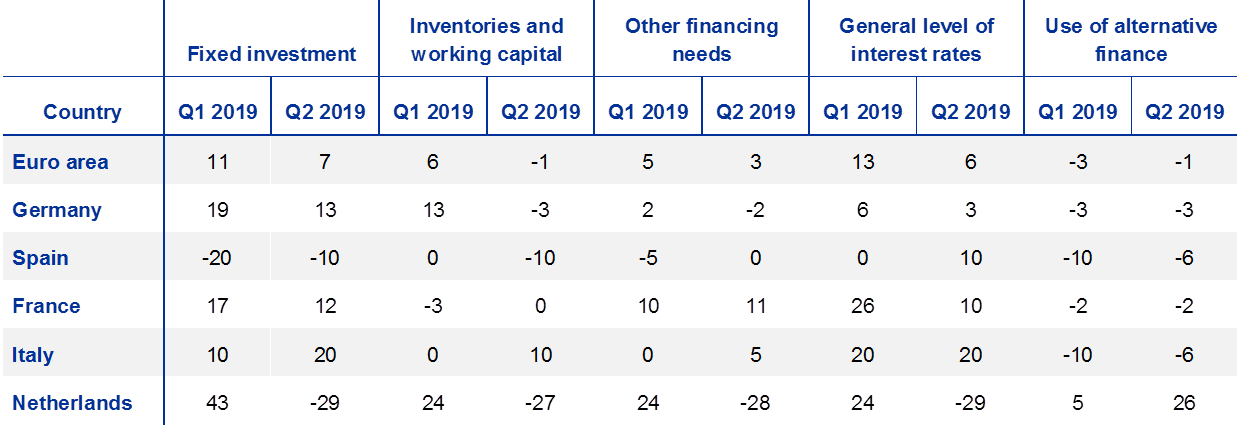
Note: See the notes to Chart 4.
Across the largest euro area countries, the low general level of interest rates supported loan demand in most major countries, except for the Netherlands. Fixed investment propped up demand in Italy, Germany and France, and dragged it down in Spain and the Netherlands. Inventories and working capital followed fixed investment in these two countries, while they had a muted impact in Germany and France and a positive impact in Italy. France and Italy registered positive impacts from M&A activity, while the Netherlands experienced the opposite effect. The reduced use of alternative financing sources had a positive impact only in the Netherlands.
For the third quarter of 2019, banks expect a net increase in loan demand from enterprises (net percentage of 5%).
2.2 Loans to households for house purchase
2.2.1 Credit standards for loans to households for house purchase remain broadly unchanged
Credit standards on loans to households for house purchase remained broadly unchanged in the second quarter of 2019, following the tightening that occurred in the previous quarter (-1%, after 3% in the previous quarter; see Chart 5 and overview table). This was in contrast with expectations of a net tightening in the last quarter. The net percentage remains below the historical average since 2003.
Across the largest euro area countries, banks eased their credit standards in Germany, France and the Netherlands, while they left them unchanged in Italy and tightened them in Spain.
Chart 5
Changes in credit standards applied to the approval of loans to households for house purchase, and contributing factors
(net percentages of banks reporting tightening credit standards and contributing factors)
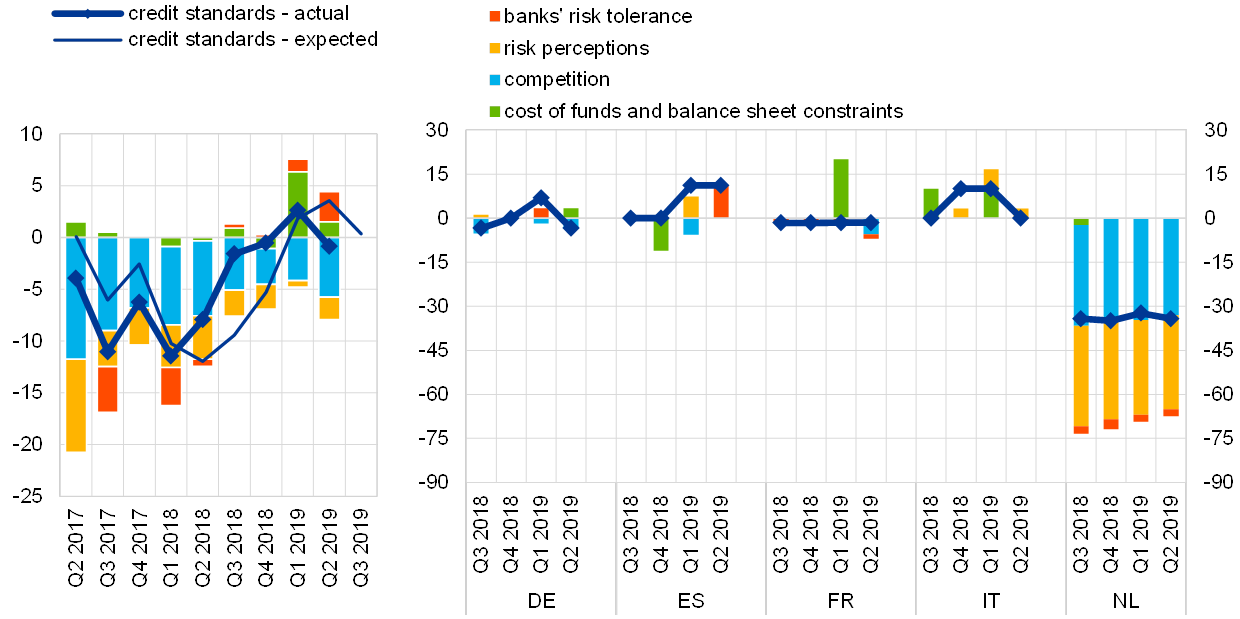
Notes: See the notes to Chart 1. “Risk perceptions” is the unweighted average of “general economic situation and outlook”, “housing market prospects, including expected house price developments” and “borrower’s creditworthiness”; “competition” is the unweighted average of “competition from other banks” and “competition from non-banks”.
Banks’ risk tolerance contributed to a tightening of credit standards together with cost of funds and balance sheet constraints, while competition continued to contribute to an easing together with reduced risk perceptions (see Chart 5 and Table 5).
Across the largest euro area countries, the reported tightening in Spain was mainly related to banks’ risk aversion. Banks in Germany referred to a tightening impact of their cost of funds and balance sheet constraints while competition contributed to an easing. In France, the reported easing was driven by pressure from competition and, to a smaller degree, by increased risk tolerance. Finally, in Italy there was a tightening contribution due to increased risk perceptions related to the general economic activity, although overall banks did not report a net further tightening after those registered in the previous two survey rounds, as the impact of cost of funds and balance sheet constraints subsided in the second quarter of 2019.
Looking ahead, euro area banks expect that credit standards for housing loans will remain broadly unchanged in the third quarter of 2019 as well.
Table 5
Factors contributing to the net tightening of credit standards for loans to households for house purchase
(net percentages of banks)
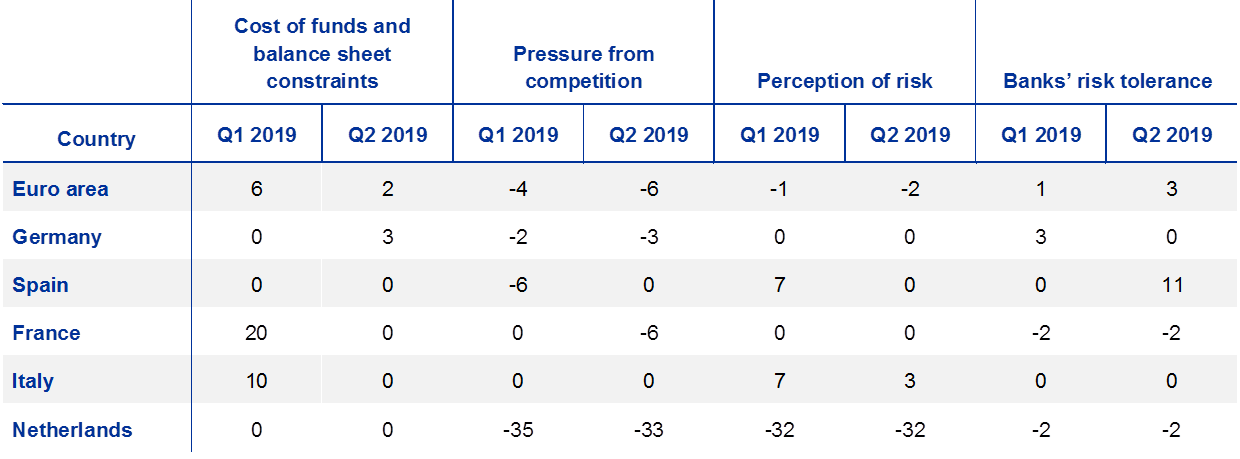
Note: See the notes to Chart 5.
2.2.2 Terms and conditions for loans to households for house purchase remained broadly unchanged
Banks’ overall terms and conditions for new loans to households for house purchase remained broadly unchanged in the second quarter of 2019 (see Chart 6 and Table 6), following an extended easing period that had already decelerated in the first quarter. The contribution to easing coming from the compression of margins on average loans since 2013 already came to a halt in the first quarter of 2019, and resumed in the last quarter with a historically low magnitude. The tightening contribution of margins on riskier loans increased to a level not registered for six years. Most other terms and conditions remained broadly unchanged.
Chart 6
Changes in terms and conditions for loans to households for house purchase
(net percentages of banks reporting tightening terms and conditions)
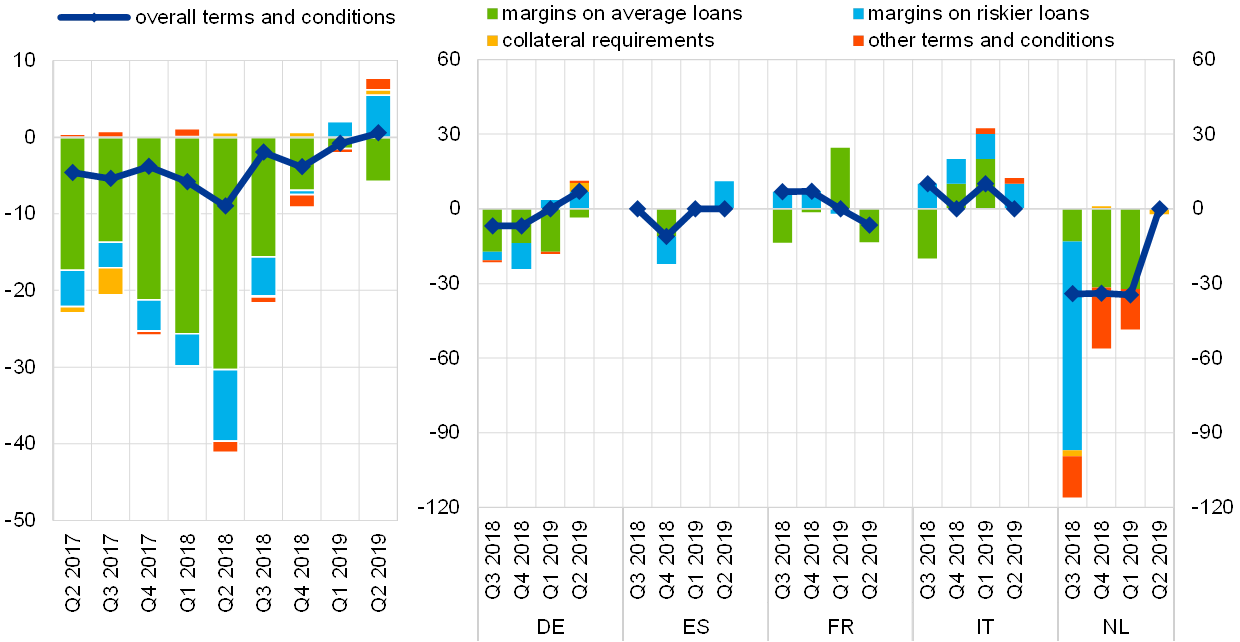
Notes: “Margins” are defined as the spread over a relevant market reference rate. “Other terms and conditions” is the unweighted average of “loan-to-value ratio”, “other loan size limits”, “non-interest rate charges” and “maturity”.
Of the largest euro area countries, banks in Germany reported a tightening of terms and conditions on housing loans driven by the increase in margins on riskier loans, which was only partially compensated by lower average margins. Margins on riskier loans increased also in Spain and Italy, although overall terms and conditions did not change in these jurisdictions. Banks in France reported a net easing overall, with margins on average loans compressing after a large tightening in the previous quarter. The widespread compression in margins observed in the Netherlands across all loan categories in the last year was met by unchanged overall terms and conditions in the second quarter of 2019.
Table 6
Changes in terms and conditions for loans to households for house purchase
(net percentages of banks)
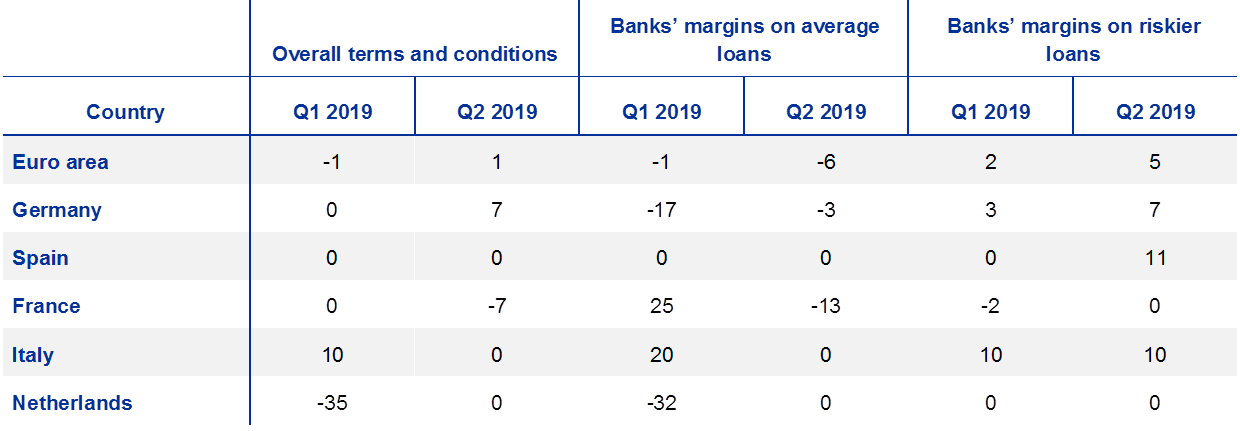
Note: See the notes to Chart 6.
While competitive pressure remained the main contributor to an easing of overall terms and conditions on housing loans at the euro area level, banks’ cost of funds and balance sheet constraints contributed to a tightening (see Table 7). Risk perceptions also had some easing impact, while banks’ risk tolerance had a broadly neutral impact on terms and conditions on housing loans at the euro area level.
While the easing impact of competitive pressures applied across most large euro area countries with the exception of Italy, the tightening impact of banks’ cost of funds and balance sheet situation was concentrated in France and Germany.
Table 7
Factors contributing to the net tightening of overall terms and conditions for loans to households for house purchase
(net percentages of banks)
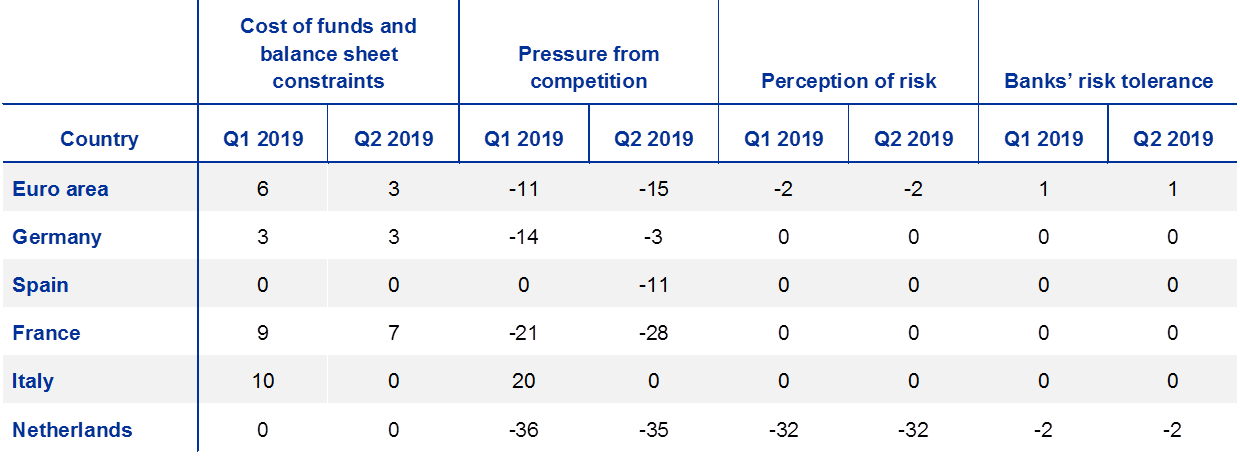
Note: The net percentages for these questions relating to contributing factors are defined as the difference between the percentage of banks reporting that the given factor contributed to a tightening and the percentage reporting that it contributed to an easing.
2.2.3 Rejection rate for housing loans increased
According to euro area banks, the net share of rejected applications for loans to households for house purchase increased again in the second quarter of 2019 (3%, after 9% in the previous survey round; see Chart 7).
Chart 7
Change in the share of rejected applications for loans to households for house purchase
(net percentages of banks reporting an increase in the share of rejections)
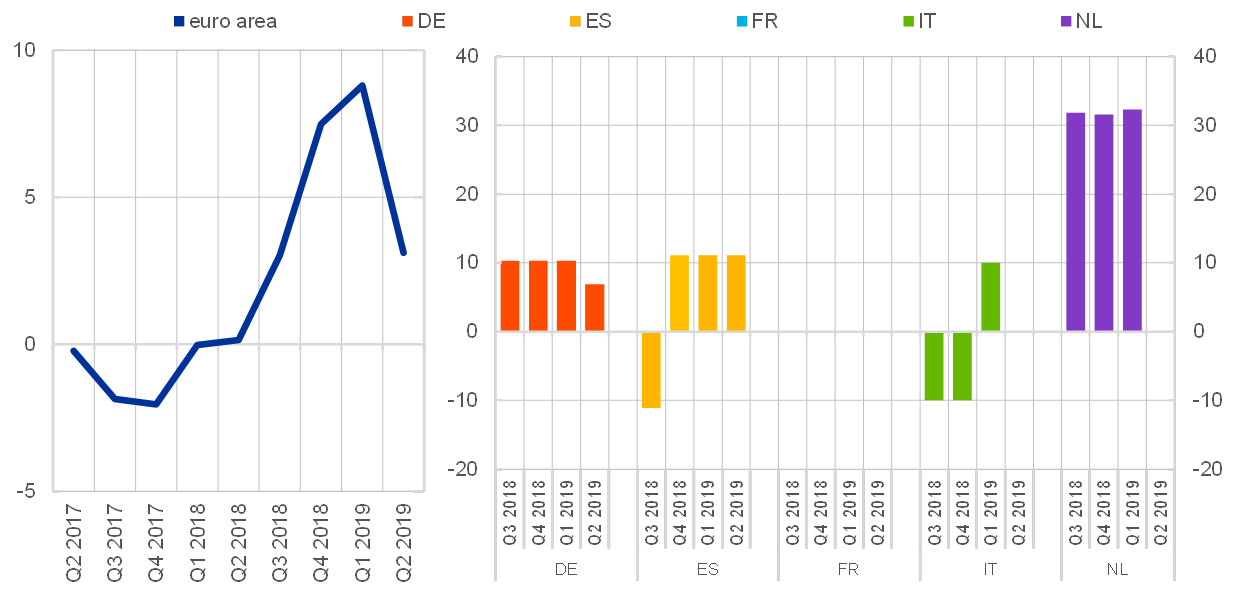
Note: Share of loan rejections relative to the volume of all loan applications in that loan category.
Across the largest euro area countries, the rejection rate for housing loans increased in Germany, Spain and the Netherlands, and remained unchanged in France and Italy.
2.2.4 Net demand for housing loans continued to increase
In the second quarter of 2019, banks reported a further net increase in demand for housing loans (26%, after 14% in the previous quarter; see Chart 8 and overview table), which was above the historical average for housing loan demand and substantially higher than expected by banks in the previous survey round.
Net demand increased in all large euro area countries, except for Spain where it remained unchanged.
Net demand for housing loans continued to be driven mainly by the low general level of interest rates, while favourable housing market prospects, consumer confidence and other financing needs contributed more than in previous quarters. The use of alternative sources of finance had no effect on demand (see Chart 8 and Table 8).
Across the large euro area countries, the low general level of interest rates had a positive impact on housing loan demand in all large countries. In addition, favourable housing market prospects supported housing loan demand in most large countries with the exception of Spain, where there was no impact. Consumer confidence supported housing demand in the Netherlands, Spain and Germany. Favourable debt refinancing, restructuring or renegotiation supported demand in Germany, France and the Netherlands, while regulatory and fiscal regimes of housing markets impacted positively demand in the Netherlands and in Spain. Finally, the use of alternative finance dampened demand in Spain as a result of the larger role of loans from other banks and households’ internal financing capacity. Lower loan volumes from other banks have instead contributed positively to net demand developments in France.
Chart 8
Changes in demand for loans to households for house purchase, and contributing factors
(net percentages of banks reporting an increase in demand and contributing factors)

Notes: See the notes to Chart 4. “Other financing needs” is the unweighted average of “debt refinancing/restructuring and renegotiation” and “regulatory and fiscal regime of housing markets”; “use of alternative finance” is the unweighted average of “internal finance of house purchase out of savings/down payment”, “loans from other banks” and “other sources of external finance”.
Table 8
Factors contributing to net demand for loans to households for house purchase
(net percentages of banks)
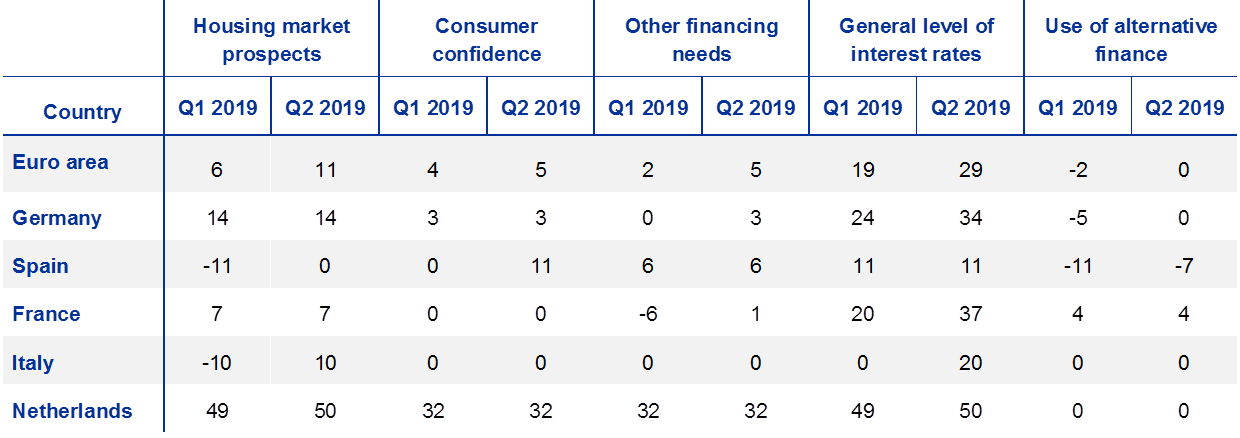
Note: See the notes to Chart 8.
For the third quarter of 2019, euro area banks expect a continued increase in net demand for housing loans (6%).
2.3 Consumer credit and other lending to households
2.3.1 Credit standards for consumer credit and other lending to households tightened
In the second quarter of 2019, credit standards for consumer credit and other lending to households tightened further (4%, increasing from 2% in the previous quarter; see Chart 9 and overview table), in contrast with broad-based expectations of a net easing in the previous round. The net percentage was in line with the historical average since 2003 and higher than any level registered since early 2013.
Across the largest euro area countries, the tightening of credit standards for consumer lending was concentrated among Spanish banks, while in the rest of the countries a neutral impact was reported.
According to euro area banks, risk tolerance had a large tightening impact, partially offset by the net easing pressure exerted by competition in the second quarter of 2019. The tightening impact of banks’ cost of funds and balance sheet constraints registered in the past three quarters has subsided and was nil in the past quarter (see Chart 9 and Table 9).
Across the largest euro area countries, the significant tightening in Spain was reported to be due mainly to a stricter attitude towards risk by banks, with a smaller role played by increased risk perceptions. Easing contributions came from competition in Germany and France, and lower risk perceptions in the Netherlands and Germany. Banks in Italy reported no change to any factor that may affect their credit standards for consumer credit and other lending.
Chart 9
Changes in credit standards applied to the approval of consumer credit and other lending to households, and contributing factors
(net percentages of banks reporting tightening credit standards and contributing factors)
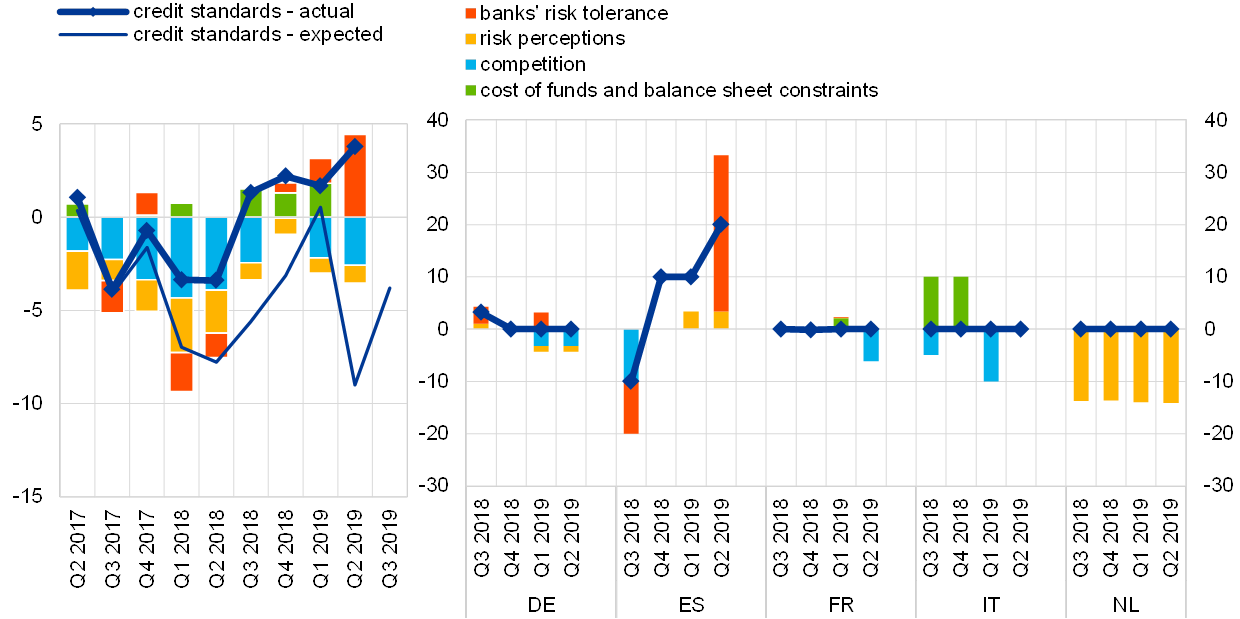
Notes: See the notes to Chart 1. “Risk perceptions” is the unweighted average of “general economic situation and outlook”, “creditworthiness of consumers” and “risk on the collateral demanded”; “competition” is the unweighted average of “competition from other banks” and “competition from non-banks”.
Looking ahead to the third quarter of 2019, euro area banks expect an easing of credit standards on consumer credit and other lending to households (-4%).
Table 9
Factors contributing to the net tightening of credit standards for consumer credit and other lending to households
(net percentages of banks)

Note: See the notes to Chart 9.
2.3.2 Terms and conditions for consumer credit and other lending to households eased slightly
In the second quarter of 2019, banks’ overall terms and conditions applied when granting new consumer credit and other lending to households eased slightly, mainly due to the compression of margins on average loans. At the same time, margins on riskier loans widened together with collateral requirements, possibly reflecting changing attitudes towards risk. The other terms and conditions remained broadly unchanged (see Chart 10 and Table 10).
Across the large euro area countries, overall terms and conditions on consumer credit and other lending to households eased in Spain and Germany, while they remained unchanged in the rest of the countries. Margins on average loans compressed across most countries, with the exception of Italy where they remained unchanged. The easing of the average margins was partially compensated by higher collateral requirements in Spain and higher margins on riskier loans in France.
Chart 10
Changes in terms and conditions for consumer credit and other lending to households
(net percentages of banks reporting tightening terms and conditions)
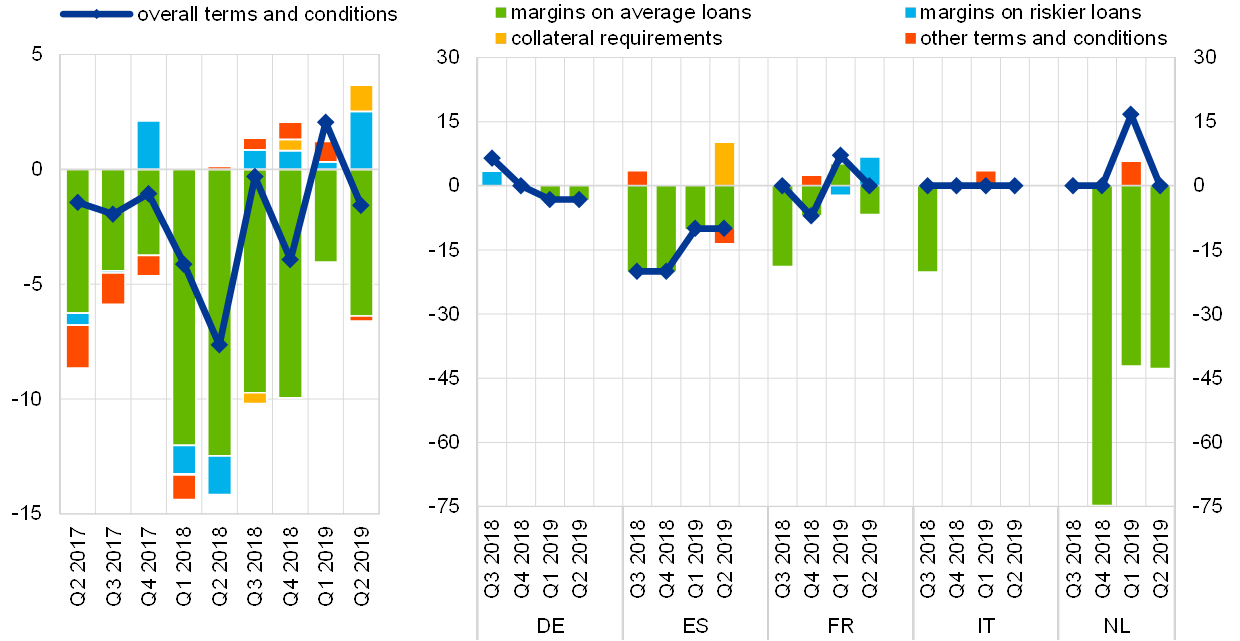
Notes: “Margins” are defined as the spread over a relevant market reference rate. “Other terms and conditions” is the unweighted average of “size of the loan”, “non-interest rate charges” and “maturity”.
Table 10
Changes in terms and conditions for consumer credit and other lending to households
(net percentages of banks)
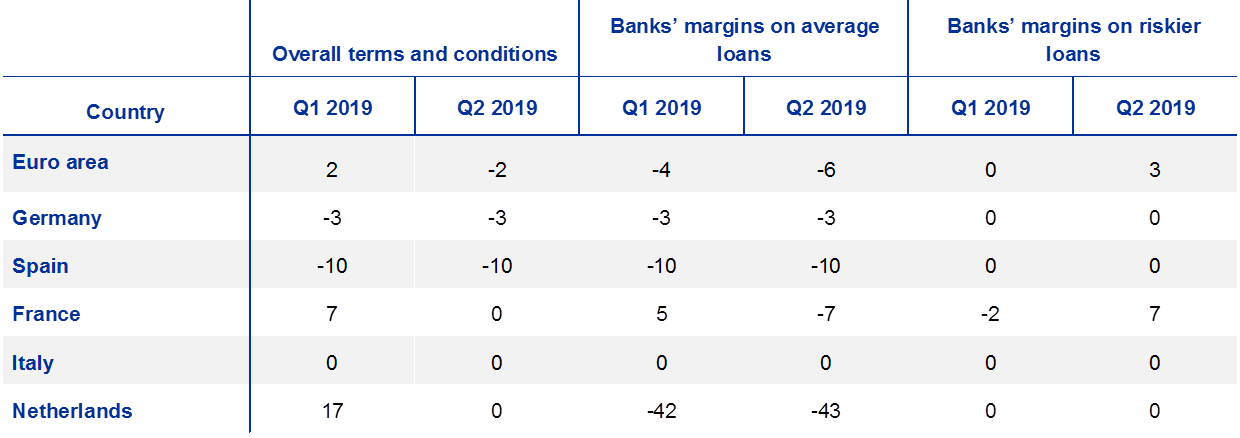
Note: See the notes to Chart 10.
The main factors underlying the tightening of terms and conditions were banks’ cost of funds and balance sheet constraints and, to a lesser extent, banks’ risk tolerance. Competitive pressures and risk perceptions continued to contribute to an easing (see Table 11).
Across the largest euro area countries, banks’ cost of funds and balance sheet constraints had a tightening impact on terms and conditions in France and Germany, where banks were likely to grant more favourable terms on loan contracts in response to competition. Banks in Spain also face heightened competitive pressure, while the reduction in perceived risk was focused in the Netherlands. The tightening impact of banks’ risk tolerance was related to developments in smaller countries.
Table 11
Factors contributing to the net tightening of overall terms and conditions for consumer credit and other lending to households
(net percentages of banks)
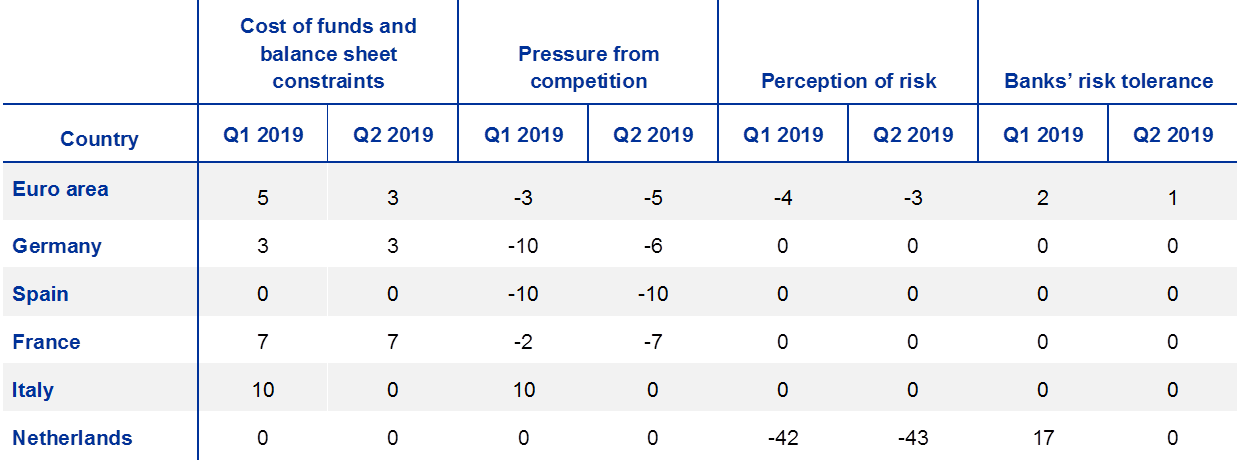
Note: The net percentages for these questions relating to contributing factors are defined as the difference between the percentage of banks reporting that the given factor contributed to a tightening and the percentage reporting that it contributed to an easing.
2.3.3 Rejection rate for consumer credit and other lending to households remained broadly unchanged
The net share of rejected applications for consumer credit and other lending to households remained broadly unchanged in the second quarter of 2019 according to reporting banks, after increasing in the previous six months (1%, after 3% in the previous survey round; see Chart 11).
Across the largest euro area countries, the rejection rate increased for banks in Spain, while it remained broadly unchanged for banks in France, Italy and the Netherlands. Banks in Germany reported a decrease in the rejection rate.
Chart 11
Change in the share of rejected applications for consumer credit and other lending to households
(net percentages of banks reporting an increase in the share of rejections)
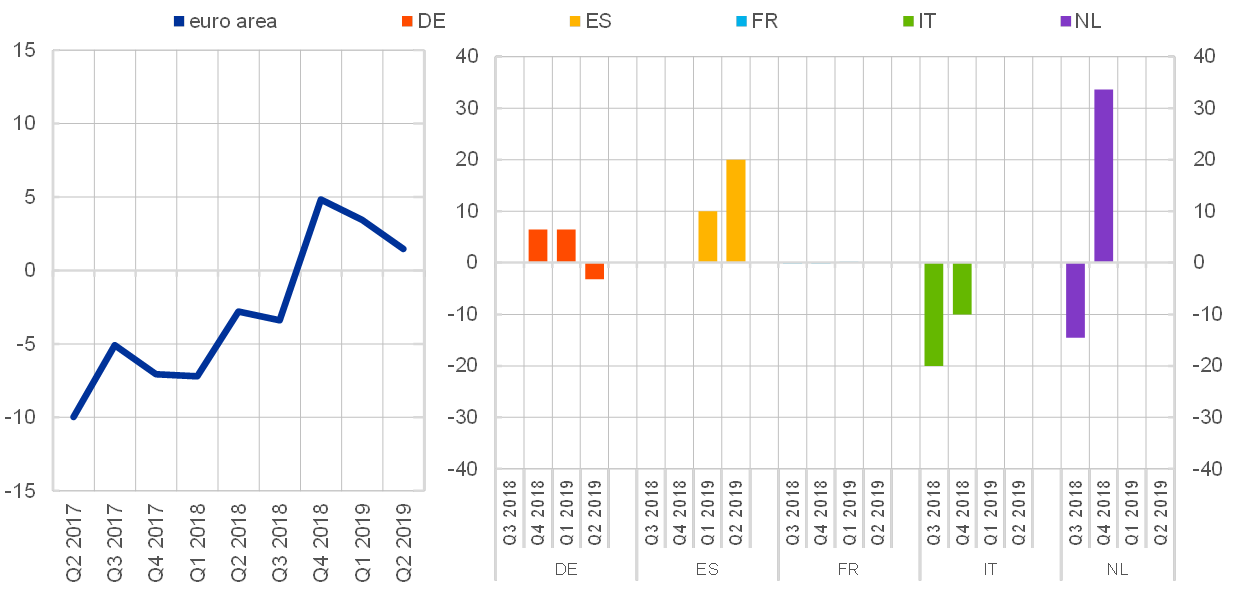
Note: Share of loan rejections relative to the volume of all loan applications in that loan category.
2.3.4 Net demand for consumer credit and other lending to households increased
According to euro area banks, net demand for consumer credit and other lending to households increased in the second quarter of 2019 (net percentage of 5%, after 2% in the previous quarter; see Chart 12 and overview table). The increase in demand was substantially lower than expected in the previous survey round, even though it stood above its historical average.
Across the large euro area countries, net demand for consumer credit and other lending to households increased in Germany and France, while it declined in Spain and Italy. It remained unchanged in the Netherlands.
Among the factors driving the demand at the euro area level, the low general level of interest rates and financing needs for spending on durable consumer goods contributed positively to demand, while consumer confidence had a neutral impact (see Chart 12 and Table 12), following a positive impact since the second quarter of 2014. In addition, the use of other financing sources dampened demand at participating banks.
Across the largest euro area countries, banks in Germany, France and the Netherlands reported a positive contribution of the general level of interest rates to demand for consumer credit. Spending on durable goods provided a negative contribution only in Italy and Spain, where the use of alternative finance also contributed negatively. Consumer confidence was particularly relevant in supporting demand in the Netherlands and France, as well as in Germany to some degree. Consumers’ assessments of economic and financial trends did not lead to an increase in demand in Spain, and even contributed to a decline in Italy.
Chart 12
Changes in demand for consumer credit and other lending to households, and contributing factors
(net percentages of banks reporting an increase in demand and contributing factors)

Notes: See the notes to Chart 4. “Use of alternative finance” is the unweighted average of “internal financing out of savings”, “loans from other banks” and “other sources of external finance”. “Consumption exp. (real estate)” denotes “consumption expenditure financed through real estate-guaranteed loans”.
Table 12
Factors contributing to net demand for consumer credit and other lending to households
(net percentages of banks)

Note: See the notes to Chart 12.
For the third quarter of 2019, euro area banks expect net demand for consumer credit and other lending to households to bounce back to a level (11%) closer to that reported on average between 2014 and 2019.
3 Ad hoc questions
3.1 Banks’ access to retail and wholesale funding
As in previous survey rounds, the July 2019 survey questionnaire included a question assessing the extent to which the situation in financial markets was affecting banks’ access to retail and wholesale funding. Banks were asked whether their access to funding had deteriorated or eased over the past three months. Negative net percentages indicate an improvement, while positive figures indicate a deterioration in net terms.
For the second quarter of 2019, euro area banks reported in net terms that their access to wholesale funding continued to improve for debt securities issuance, especially in the medium to long-term end of the curve, in line with bank bond market developments. Access to the interbank unsecured money market was also reported to have improved, while access to securitisation improved marginally and within a scope limited to the corporate loan segment (see Chart 13 and Table 13).[7] As regards access to retail funding, for the second consecutive quarter banks indicated an improvement, which was generalised across maturities but especially pronounced for short-term deposits.
Chart 13
Banks’ assessment of funding conditions and the ability to transfer credit risk off the balance sheet
(net percentages of banks reporting a deterioration in market access)
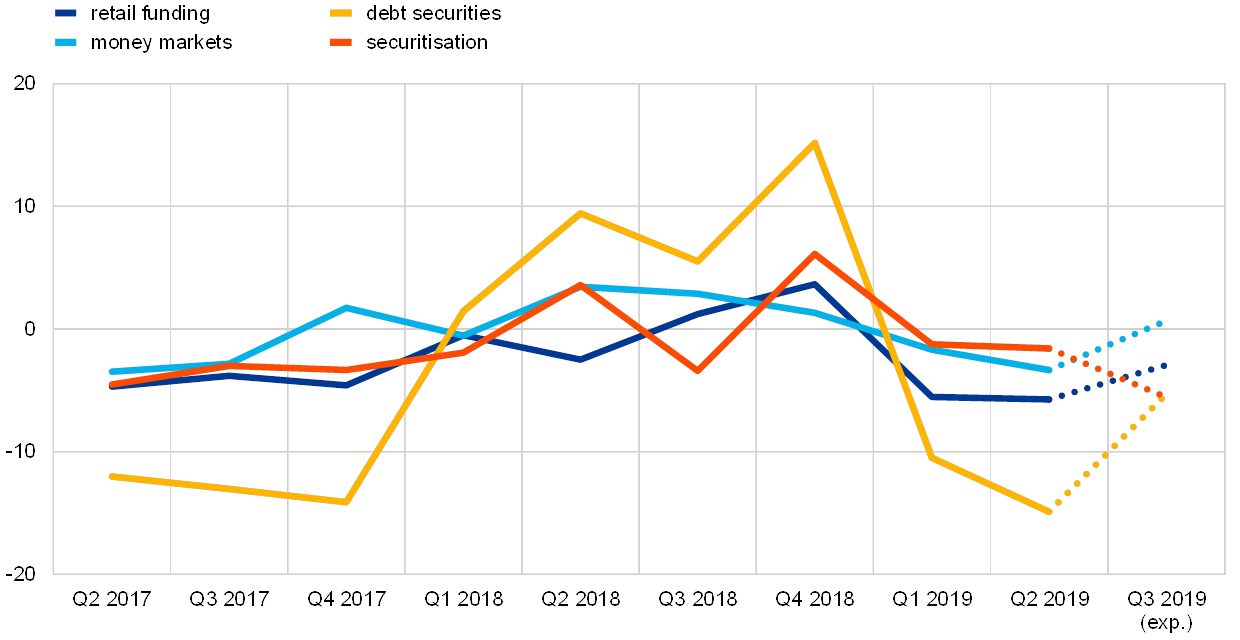
Note: The net percentages are defined as the difference between the sum of the percentages for “deteriorated considerably” and “deteriorated somewhat” and the sum of the percentages for “eased somewhat” and “eased considerably”.
Looking ahead to the third quarter of 2019, euro area banks expect a further improvement in their access to debt securities markets, retail funding and securitisation, while access to money markets should remain unchanged.
Table 13
Banks’ assessment of funding conditions and the ability to transfer credit risk off the balance sheet
(net percentages of banks reporting a deterioration in market access)

Note: See the notes to Chart 13.
3.2 Banks’ adjustment to regulatory and supervisory action
The July 2019 BLS questionnaire included two biannual ad hoc questions to assess the extent to which new regulatory or supervisory requirements affected banks’ lending policies via the potential impact on their capital, leverage, liquidity position or provisioning and the credit conditions that they apply to loans. These new requirements cover regulatory or supervisory action that has recently been implemented or that is expected to be implemented in the near future. Furthermore, banks were also asked to indicate the effect of these actions on their funding conditions.
Chart 14
Impact of regulatory or supervisory action on banks’ risk-weighted assets, capital and funding conditions
(net percentages of banks)
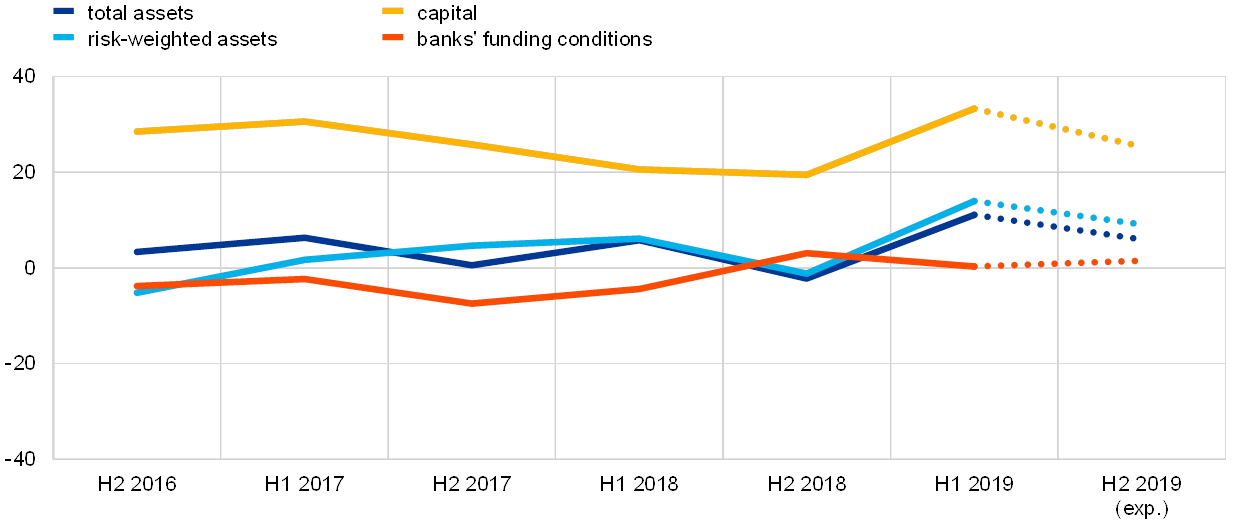
Notes: For “total assets”, “risk-weighted assets” and “capital”, the net percentages are defined as the difference between the sum of the percentages for “increased considerably” and “increased somewhat” and the sum of the percentages for “decreased somewhat” and “decreased considerably”. For “banks’ funding conditions”, the net percentages are defined as the difference between the sum of the percentages for “experienced a considerable tightening” and “experienced a moderate tightening” and the sum of the percentages for “experienced a moderate easing” and “experienced a considerable easing”.
Table 14
Impact of regulatory or supervisory action on banks’ risk-weighted assets, capital and funding conditions
(net percentages)

Note: See the notes to Chart 14.
In relation to regulatory or supervisory actions, euro area banks indicated a continued strengthening of their capital position in the first half of 2019 (see Chart 14 and Table 14), through both retained earnings and capital issuance. Euro area banks also replied that their total assets increased in the first half of 2019, with liquid assets continuing to increase under regulatory or supervisory pressure. Banks’ risk-weighted assets also increased in the first half of 2019 owing to an increase in average loans while riskier loans remained unchanged. Banks did not indicate funding conditions moving in any direction on average as a result of regulatory or supervisory actions.
Chart 15
Contribution of regulatory or supervisory action to the tightening of banks’ credit standards and margins
(net percentages of banks)
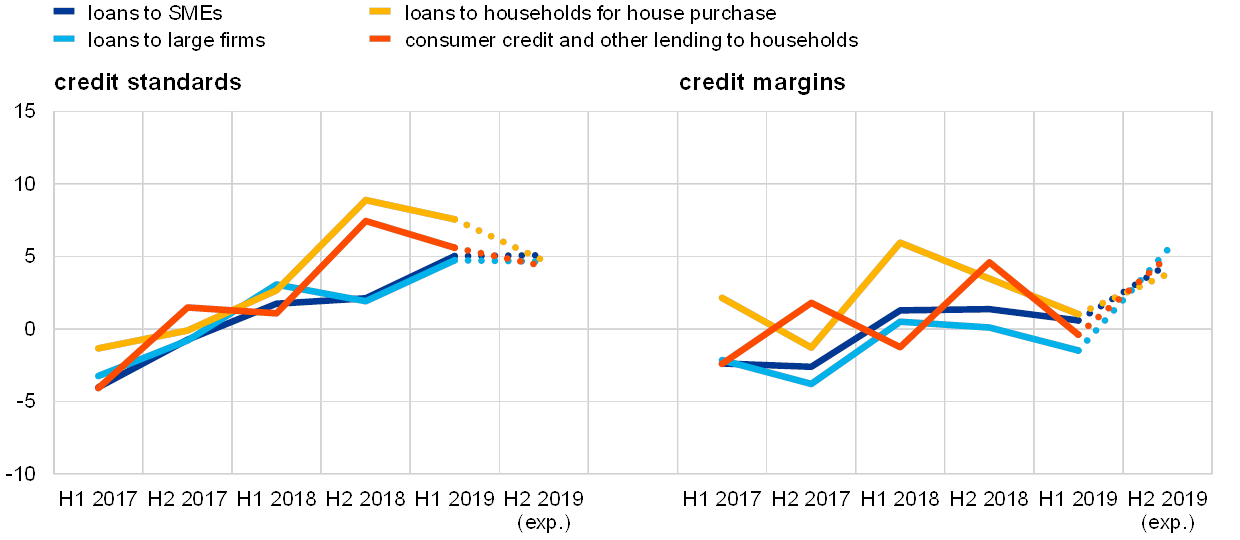
Notes: The net percentages are defined as the difference between the sum of the percentages for “tightened considerably” and “tightened somewhat” and the sum of the percentages for “eased somewhat” and “eased considerably”.
Banks continued to report a net tightening impact on their credit standards due to supervisory or regulatory actions in the first half of 2019 (see Chart 15 and Table 15). Differently from the second half of 2018 where the effect was more pronounced for housing loans and consumer credit, banks reported that they had tightened credit standards across all loan categories. This was not the case for credit margins, for which the impact was broadly neutral with the exception of a slight easing for loans to large enterprises.
Looking ahead to the second half of 2019, euro area banks expect regulatory or supervisory actions to lead to a further strengthening of their capital position and an increase in their assets both in total and risk-weighted terms. In addition, they expect regulatory or supervisory actions to have a tightening impact on credit standards and a widening impact on credit margins across all loan categories.
Table 15
Contribution of regulatory or supervisory action to the tightening of banks’ credit standards and margins
(net percentages)

Note: See the notes to Chart 15.
3.3 The impact of banks’ NPL ratios on their lending policies
The July 2019 survey questionnaire included an ad hoc question on the impact of banks’ NPL ratios on changes in their lending policy and the factors via which the NPL ratios contributed to changes of their lending policies. Banks were asked about the impact on loans to enterprises, on loans to households for house purchase and on consumer credit and other lending to households over the past six months and over the next six months.
Euro area banks indicated a net tightening impact of their NPL ratios on credit standards for all loan categories in the first half of 2019, although the impact was more contained than in the previous semester for loans to enterprises and housing loans (see Chart 18). With respect to changes in banks’ credit terms and conditions, euro area banks reported a net tightening impact of NPL ratios on their terms and conditions only for consumer lending, while for the rest of the loan categories terms and conditions were broadly unaffected by NPL ratios in net terms over the past six months.
Over the next six months, euro area banks expect a net tightening impact of their NPL ratios on credit standards and on credit terms and conditions for loans to enterprises and consumer credit, while they expect broadly unchanged lending policies for housing loans.
With regard to the factors through which banks’ NPL ratios affected banks’ lending policies (changes in credit standards and terms and conditions), euro area banks reported that NPL ratios led to a tightening of their lending policies to enterprises and households in net terms mainly through risk perceptions and risk aversion over the past six months (see Chart 19). To a lesser extent, NPL ratios also affected their lending policies via banks’ capital positions, pressure related to supervisory actions and, to a smaller degree, costs related to balance sheet clean-up operations. Access to market financing was an important factor in determining the tightening impact of NPL ratios on lending policies in the second half of 2018, while it had a neutral impact over the past six months.
Chart 18
Impact of banks’ NPL ratio on changes in their credit standards and terms and conditions
(net percentages of banks, over the past and next six months)

Notes: The NPL ratio is defined as the stock of gross NPLs on a bank’s balance sheet as a percentage of the gross carrying amount of loans. Changes in credit standards and/or terms and conditions can be caused by changes in the NPL ratio or by changes in regulation or in the bank’s assessment of the level of the NPL ratio, even if the NPL ratio has remained unchanged. Net percentages are defined as the difference between the sum of the percentages for “contributed considerably to tightening” and “contributed somewhat to tightening” and the sum of the percentages for “contributed somewhat to easing” and “contributed considerably to easing”. The periods in the legend refer to the respective BLS rounds. “Expected” denotes expectations indicated by banks in the current round.
Looking ahead, the range of factors reported in this survey round by euro area banks are expected to remain broadly in place over the next six months as well, with the addition of a possible deterioration in liquidity positions.
Chart 19
Contribution of factors through which the NPL ratio affects banks’ policies on lending to enterprises and households
(net percentages of banks, over the past and next six months)
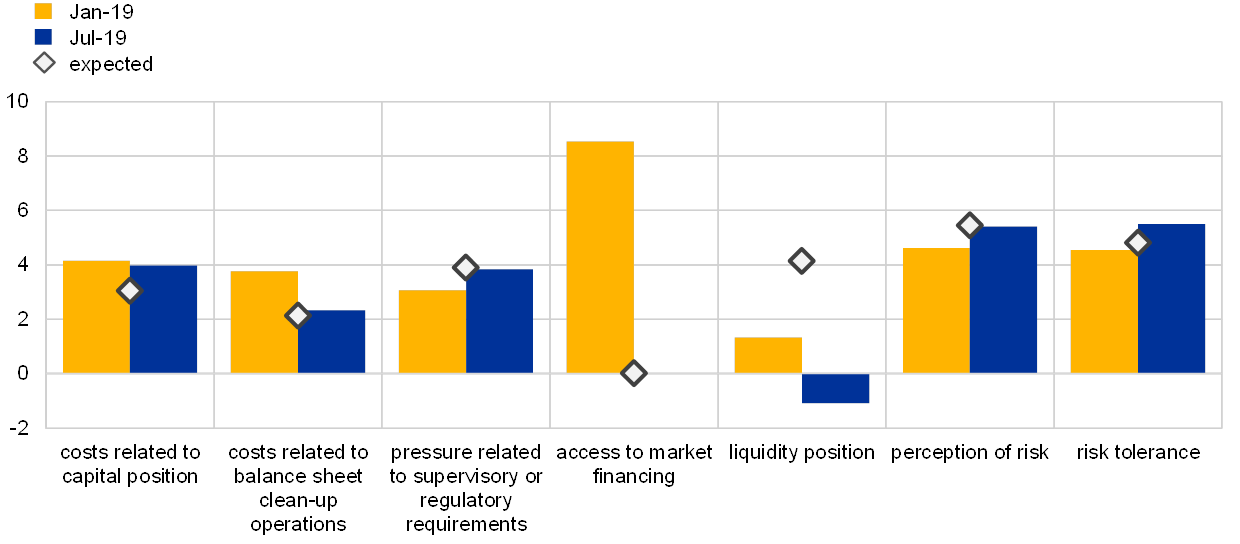
Notes: See the notes to Chart 18.
Annexes
See more.
© European Central Bank, 2019
Postal address 60640 Frankfurt am Main, Germany
Telephone +49 69 1344 0
Website www.ecb.europa.eu
All rights reserved. Reproduction for educational and non-commercial purposes is permitted provided that the source is acknowledged.
For specific terminology please refer to the ECB glossary.
PDF ISSN 1830-5989, QB-BA-19-003-EN-N
HTML ISSN 1830-5989, QB-BA-19-003-EN-Q
- The five largest euro area countries in terms of gross domestic product are Germany, France, Italy, Spain and the Netherlands.
- For more detailed information on the bank lending survey, see the article entitled “A bank lending survey for the euro area”, Monthly Bulletin, ECB, April 2003; and Köhler-Ulbrich, P., Hempell, H. and Scopel, S., “The euro area bank lending survey”, Occasional Paper Series, No 179, ECB, 2016.
- In this case, the selected sample banks are generally of similar size or their lending behaviour is typical of a larger group of banks.
- The non-harmonised historical data differ from the harmonised data mainly as a result of heterogeneous treatment of “NA” replies and specialised banks across questions and countries. Non-harmonised historical BLS data are published for discontinued BLS questions and ad hoc questions.
- The calculation of a simple average when combining factors in broader categories assumes that all factors have the same importance for the banks. This partly explains some inconsistencies in the respective charts between developments in credit standards and developments in the main underlying factor categories.
- The calculation of a simple average when combining factors in broader categories assumes that all factors have the same importance for the banks. This partly explains some inconsistencies between developments in demand for loans and developments in the main underlying factor categories.
- As regards the results for securitisation, a large number of banks (between 41% and 52%, depending on the type of securitisation) replied “not applicable” on the grounds that this source of funding is not relevant for them.


